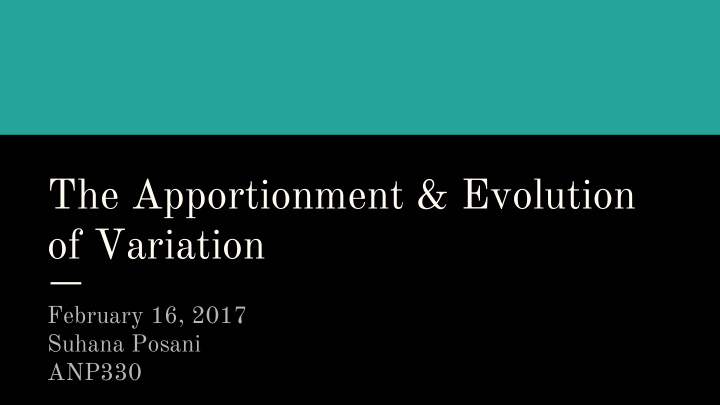



The Apportionment & Evolution of Variation February 16, 2017 Suhana Posani ANP330
Key Concepts/Terms Genotype, DNA, and phenotype: 1. “Our genotype is converted into a phenotype through the developmental process which is occurring in a particular environment. And every environment is different, and environments are changing all the time.” 2. The “Recent Out of Africa” model: “ The accumulated data for essentially all genetic markers argue strongly for the considerable loss of variation associated with the expansion out of Africa.” “It is now accepted that the population that expanded out of Africa became the founder of all non-African human populations” “What is clear is that modern humans expanded out of Africa within the last 100,000 years.”
Key Concepts/Terms continued 3. Genetic Genealogy: “allows individuals to explore their own ancestry using commercial kits that test their DNA.” “Consumers can choose from three different tests to receive a report on the geographic ancestry of their DNA. One test examines mitochondrial DNA, which is passed from a mother to her children. Another examines Y-chromosome DNA, passed from a father to his sons. A third test looks for “Ancestry Informative Markers” in a person’s DNA.”
Key Historical Events 1. “The Appointment of Human Variation” a 1972 paper by Richard Lewontin “Most variation occurs within a local group, then some occurs between groups but still within the race, and then a small percentage, certainly less than 10 percent and probably more like 6 percent among race” Based on his study of blood polymorphisms “These results have been repeated over and over again”
Key Historical Events continued 2. The Dionne Quintuplets Five girls, all identical quintuplets They were put in a “zoo” to be looked at, all presented as alike as possible Once older and out of the “zoo”, they developed quite differently “A couple became nuns, some were married and some not, two died and three are still alive – I think a third one died recently. One was schizophrenic, the others weren’t. They were as different from each other as any five girls could be, although they still looked pretty much alike.” Nurture vs Nature: They appeared the same, but once out of the same environment, their mental characteristics changed, though physically they all stayed the same
Relation to Other Concepts - There is more variation in Sickle Cell Disease within local groups than between. - Variation in one trait doesn't correspond to variation in another, traits are continuous. - “Most variation occurs within Africa and non-Africans are a subset of Africans.” (pg. 131)
Thinking About Race in New Ways - There is no such thing as “race traits.” - Ex. “White traits” - narrow nose, straight hair. - Ex. “Black traits” - wide nose, coily/kinky hair. - Migration and trading patterns can show which peoples interacted and when. Where there was product trade there was almost always genetic transfers as well. - “We are all one big breeding group.” (pg. 140)
Related Example Article: The hoopla over these “rare” biracial twins twins reveals how confused people are about racial identity ● Twin girls from Quincy, Illinois ● Parents are two different races ● Article suggests “that one twin is black and the other is white… suggests that these twins are “so rare” because their complexions are different enough that they belong to different racial groups.” http://www.vox.com/2017/1/29/14377940/biracial-twi ns-black-white-race-identity
Discussion Questions 1. With the 1972 publication of Lewontin’s “The Apportionment of Human Variation” that showed that human variation was “almost entirely local”, why was/is there still a large emphasis on scientifically classifying people by race? 2. As patterns of migration keep changing, with different advancements in technology, how do you think society’s ideas of race and categories of race themselves will change?
Recommend
More recommend